 The symbol of Kumamoto
The symbol of KumamotoKumamoto Castle is one of the three greatest castles in Japan. This magnificent
fortress was constructed in 1601 by the first ruling domain lord of the region, Kato Kiyomasa, a
renowned castle builder and strategist. Taking 7 years to complete, the castle is nothing like any
other. Following the ruling by the Kato clan, it was then occupied by the Hosokawa clan during the
Edo period.
This symbolic landmark of Kumamoto City features "musha-gaeshi" stone walls to combat intruders and
newly-reconstructed extravagant Honmaru Goten Palace. The castle premises is a great cherry blossom
viewing spot, drawing tons of spectators during the blooming season. The 2016 Kumamoto Earthquake
has left many of the on-site structures severely damaged including the stone walls, the tenshukaku
main tower, and others designated as Important Cultural Properties.Restoration of the tenshukaku
tower is planned for the year 2019, as for the entire premises is projected to be re-established in
the next 20 years. Entering the Honmaru Palace is currently prohibited; however, the Ninomaru Palace
courtyard and Kato Shrine within the premises should provide a stunning view of it.
Our wish for all visitors is that this would provide an unique opportunity to witness the rebuilding
process of Kumamoto Castle.
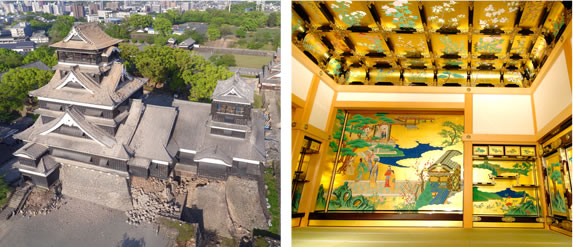
 Daily life with quality drinking water
Daily life with quality drinking waterEven with population of over 740,000, Kumamoto City is able to provide all of its water
needs from the natural groundwater resource. It is the largest in the country for a city with over
50,000 in population. This makes Kumamoto one of the rarest groundwater city in the entire world.
The ground formed by Mt. Aso's volcanic ashes here in Kumamoto soaks up water very quickly. The
rainfall on the high Aso mountains would eventually trickle down to the city area in about 20 years
time. As the water dissolves various mineral contents in the soil, it turns to the great tasting,
healthy natural groundwater. It should be noted that the yearly rainfall in this region is well
above the national average, and that the paddy field irrigation in the area developed by the feudal
lord Kato Kiyomasa about 420 years ago adds to creating this abundant natural groundwater resource
of the region.
Such is the blessed daily life here in Kumamoto where quality mineral water is
available right at your faucet every day for all your life necessities including drinking, cooking,
and bathing.
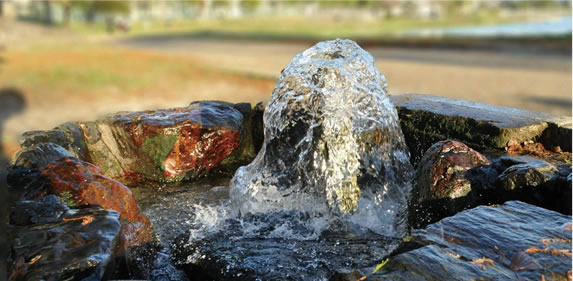
 "Food produce"
"Food produce"Abundant in clean groundwater and various natural resources, Kumamoto City is a
fruitful producer of rice, vegetables, fruits, flowers, stock farm products, and many other
agricultural commodities. The city is ranked the third highest in total production among all
prefectures and government-designated municipalities, while coming in at 8th among all
city-town-village municipalities in the entire country (2014 data). Kumamoto is, in fact, one of the
nation's leading producers of watermelons, melons, eggplants, and tangerines.
Though the usual
local specialties of Kumamoto are known to be the likes of "basashi" (raw horse meat), "karashi
renkon" (lotus root with mustard), and "Kumamoto ramen noodles," various types of country cuisines
and local specialty dishes made with pure groundwater and fresh produce of each region should also
satisfy your taste buds!
Why not go beyond just sightseeing and fully savor the tastes of "Kumamoto" during your stay?
Guaranteed to meet your expectation!
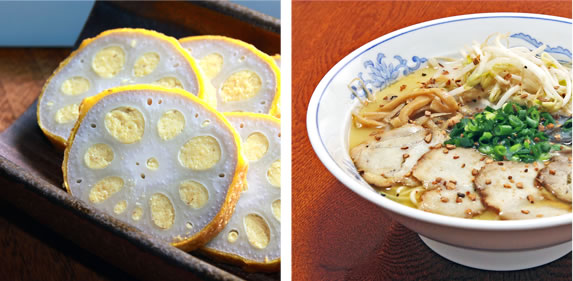
 Places of nature and healing in the midst of
the city
Places of nature and healing in the midst of
the cityIn the midst of bustling Kumamoto City are some nature-filled places of rest and
healing. First up is a must-stop tourist destination in Kumamoto, Suizenji Jojuen Garden.
Designated as a National Scenic Beauty and a Historic Site, this Momoyama-style stroll garden with a
central pond opened in 1636 on the former premises of the tea house belonging to then-Kumamoto
domain ruling Hosokawa clan.
The central pond is made up of Aso's groundwater. Its translucent clean water is as if it can purify
your souls as you gaze into it.
Lake Ezu is only about 15 minutes by car from the heart of Kumamoto City. Approximately 6 km in
perimeter, this body of water is divided into two: Kamiezu and Shimoezu. It is quite rare for a
Japanese metropolitan area to feature a natural lake of this size, thus making it a great resting
place for the city residents.
The lake area is equipped with a promenade and a grassy park, suitabl ffor a little walk as well as
wildlife watching for aquatic and wild bird habitat on site.
Drive about 40 minutes north on National Road 3 from downtown Kumamoto City, and you will find
yourself in the "inner parlor of Kumamoto," Ueki Onsen. This tranquil rural hot spring district is
situated along the clear current Goshi River. Offered at various inns and day-trip communal baths,
the hot tubs of Ueki is known to turn your skin "as smooth as the marble."
Get rejuvenated in the hot springs of this nature-filled rural town.
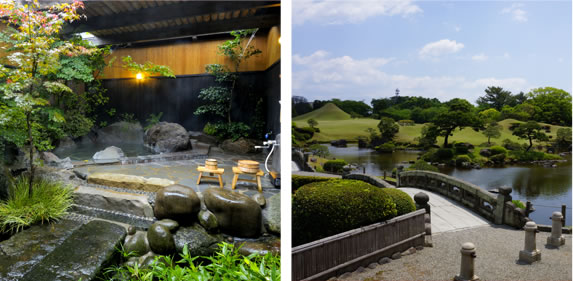
 A popular figure of Kumamoto running through
the city,
A popular figure of Kumamoto running through
the city,Kumamoto City's City Tram first started its operation back in 1924. Consisting of two
lines running east to west, the City Tram continues to serve many citizens and tourists in the city
today. The style of the carts can vary from retro and classic ones to new COCOROs just installed in
2014. The ride fee is all flat rate anywhere throughout the city, and the carts are domestic
transportation IC cards compatible for payments.This beloved mass transit of Kumamoto offers unique
seasonal rides including the summertime "beer garden tram" as well as the "illumination tram" with
light decors during the Christmas season.
Linking all major destinations such as Kumamoto
Station, Kumamoto Castle, Suizenji Jojuen Garden, and the arcade shopping district, the City Tram is
a great way to get around the city even for tourists. The 1-Day Pass for 500 yen gives you unlimited
rides anywhere in the city all day long. It should also be fun fully capturing different looks of
Kumamoto City out of this moving streetcar as well.
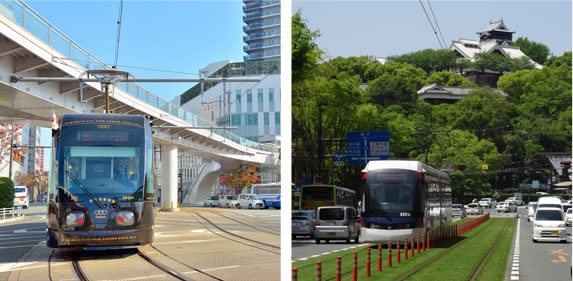
 "Kyushu's hub city"
"Kyushu's hub city"Kumamoto City is located in central Kyushu, which gives it a great geographical
advantage. Bullet train Kyushu Shinkansen opened in 2011, now connecting Kumamoto with Fukuoka City
(via Hakata Station) by 33 minutes and with Kagoshima City (via Kagoshima-Chuo Station) by 44
minutes on the fastest routes, respectively.
This has not only made the area more livable, but
also more convenient for leisure travels as well. Neighboring all the other 6 prefectures on the
island, traveling from Kumamoto to various tourist destinations is simple and easy.
Reaching
various parts within the prefecture is also very convenient. With Aso being just to the east and
Amakusa being just to the west, Kumamoto City provides an instant access to various major tourist
locations nearby.
Travel throughout Kumamoto and the rest of Kyushu as Kumamoto City as your central location for
maximizing your travel experience here in Kyushu.
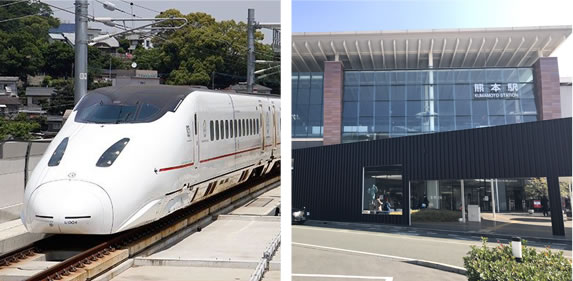

 Kumamoto City's attractive
Kumamoto City's attractive"Mokkosu" and "wasamon" are phrases often used to describe the nature of Kumamoto
people. "Mokkosu" is an expression typically used to describe a man of a strong conviction or of a
stubborn mind. It is not a derogatory term, however. This complimentary word simply means that he is
a man of principle."Wasamon" is also used as a compliment when describing someone with an
adventurous affinity toward new things.
All the above traits -- strong conviction, passion, and
affinity for new things -- nurture talents in areas such as art, entertainment, sports, and various
cultures. We highly encourage you to strike a conversation with the locals during your visit in
Kumamoto. Kumamoto citizens are more likely to respond and to interact with you with lots of
enthusiasm. That, within itself, is a fun part of traveling!